Key Specs
Since many of our users are going to want to run different OSes on this, we wanted to give some of the key hardware specs. There is a lot on these machines that are customizable, but this at least gives you some sense of what hardware is available. If you want to know if your hardware is compatible with your OS, this list should help do that tie-out.
CPU Support
Here are the officially supported CPUs for the unit:
| Processor Name | Cores | Threads | Base Frequency | Max Frequency | Cache | Memory Support | Processor Graphics |
| Celeron G5900 | 2 | 2 | 3.4GHz | – | 2MB | DDR4-2666 | Intel UHD Graphics 610 |
| Celeron G5900T | 2 | 2 | 3.2GHz | – | 2MB | DDR4-2666 | Intel UHD Graphics 610 |
| Celeron G5905 | 2 | 2 | 3.5GHz | – | 4MB | DDR4-2666 | Intel UHD Graphics 610 |
| Celeron G5905T | 2 | 2 | 3.3GHz | – | 4MB | DDR4-2666 | Intel UHD Graphics 610 |
| Celeron G5920 | 2 | 2 | 3.5GHz | – | 2MB | DDR4-2666 | Intel UHD Graphics 610 |
| Celeron G5925 | 2 | 2 | 3.6GHz | – | 4MB | DDR4-2666 | Intel UHD Graphics 610 |
| Pentium Gold G6400 | 2 | 4 | 4.0GHz | – | 4MB | DDR4-2666 | Intel UHD Graphics 610 |
| Pentium Gold G6400T | 2 | 4 | 3.4GHz | – | 4MB | DDR4-2666 | Intel UHD Graphics 610 |
| Pentium Gold G6500 | 2 | 4 | 4.1GHz | – | 4MB | DDR4-2666 | Intel UHD Graphics 630 |
| Pentium Gold G6500T | 2 | 4 | 3.5GHz | – | 4MB | DDR4-2666 | Intel UHD Graphics 630 |
| Pentium Gold G6600 | 2 | 4 | 4.2GHz | – | 4MB | DDR4-2666 | Intel UHD Graphics 630 |
| Core i3-10100 | 4 | 8 | 3.6GHz | 4.3GHz | 6MB | DDR4-2666 | Intel UHD Graphics 630 |
| Core i3-10100T | 4 | 8 | 3.0GHz | 3.8GHz | 6MB | DDR4-2666 | Intel UHD Graphics 630 |
| Core i3-10300 | 4 | 8 | 3.7GHz | 4.4GHz | 8MB | DDR4-2666 | Intel UHD Graphics 630 |
| Core i3-10300T | 4 | 8 | 3.0GHz | 3.9GHz | 8MB | DDR4-2666 | Intel UHD Graphics 630 |
| Core i3-10320 | 4 | 8 | 3.8GHz | 4.6GHz | 8MB | DDR4-2666 | Intel UHD Graphics 630 |
| Core i5-10400 | 6 | 12 | 2.9GHz | 4.3GHz | 12MB | DDR4-2666 | Intel UHD Graphics 630 |
| Core i5-10400T | 6 | 12 | 2.0GHz | 3.6GHz | 12MB | DDR4-2666 | Intel UHD Graphics 630 |
| Core i5-10500 | 6 | 12 | 3.1GHz | 4.5GHz | 12MB | DDR4-2666 | Intel UHD Graphics 630 |
| Core i5-10500T | 6 | 12 | 2.3GHz | 3.8GHz | 12MB | DDR4-2666 | Intel UHD Graphics 630 |
| Core i5-10600 | 6 | 12 | 3.3GHz | 4.8GHz | 12MB | DDR4-2666 | Intel UHD Graphics 630 |
| Core i5-10600T | 6 | 12 | 2.4GHz | 4.0GHz | 12MB | DDR4-2666 | Intel UHD Graphics 630 |
| Core i7-10700 | 8 | 16 | 2.9GHz | 4.8GHz | 16MB | DDR4-2933 | Intel UHD Graphics 630 |
| Core i7-10700T | 8 | 16 | 2.0GHz | 4.5GHz | 16MB | DDR4-2933 | Intel UHD Graphics 630 |
| Core i9-10900 | 10 | 20 | 2.8GHz | 5.2GHz | 20MB | DDR4-2933 | Intel UHD Graphics 630 |
| Core i9-10900T | 10 | 20 | 1.9GHz | 4.6GHz | 20MB | DDR4-2933 | Intel UHD Graphics 630 |
RAM Support
- Up to 2x 32GB DDR4 SODIMMs (64GB total) DDR4-2933/ 2666 depending on the CPU used
Storage Support
- 2x M.2 PCIe Gen3 for NVMe SSD slots
- 1x 2.5″ SATA
Networking (Wired)
- Intel i219-LM
WiFi Support (Optional)
- Intel Wi-Fi 6 AX201, 11ax 2×2 Wi-Fi + Bluetooth 5.1, Intel vPro technology support, M.2 Card
- Intel Wireless-AC 9560, 11ac Dual Band 2×2 Wi-Fi + Bluetooth 5.0, M.2 card
- Realtek RTL8822CE, 11ac Dual Band 2×2 Wi-Fi + Bluetooth 5.0, M.2 card
USB Ports
- 2x USB 3.2 Front (1x Type-A Gen2, 1x Type-C Gen1)
- 2x USB 3.2 Gen2 Rear (Type-A)
- 2x USB 3.2 Gen1 Rear (Type-A)
- Options for additional ports, as configured with a USB 3.2 Gen1 Type-C with DisplayPort)
OSes From Factory
- Windows 10 Home (64-bit)
- Windows 10 Pro (64-bit)
- Windows 10 IoT Enterprise
- Ubuntu Linux
- No OS
The OS section can be a big deal. Sometimes the units are advertised as supporting Windows 10, but one gets a Windows 10 Home license. If you want to, or may want to, run Windows 10 Pro, knowing exactly which OS is on the device is ultra important. Having Ubuntu Linux installed from the factory is nice since we know many of our readers will use these with Linux. We also had our system running Proxmox VE as a Linux virtualization node but that is not an officially supported OS. Ubuntu installed without issue. One also usually needs to make BIOS tweaks in order to run Linux on Lenovo machines since they are optimized for Windows but we did not with our test unit.
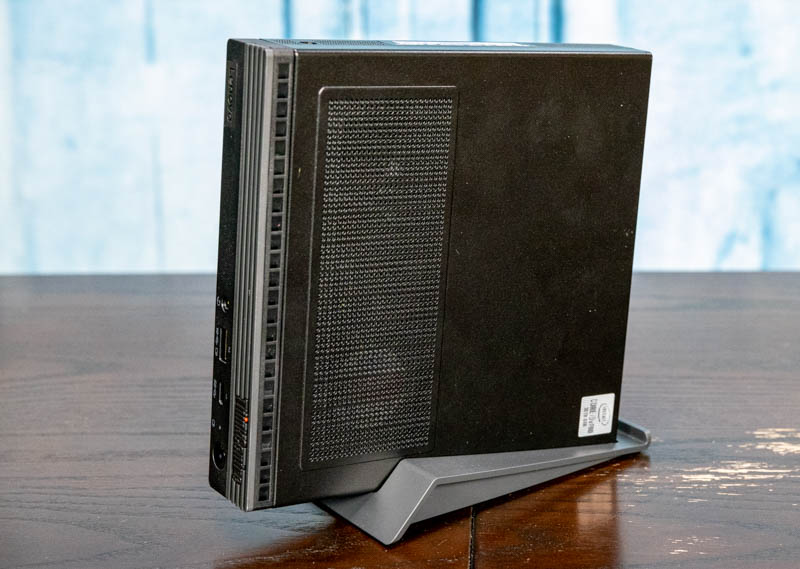
Note: These systems sometimes change specs mid-generation. If you find another spec sheet with items you think we should add, please let us know in the comments.
Next, we are going to look at the performance and power consumption before getting to our final words.
Lenovo ThinkCentre M90q Tiny Performance and Power Consumption
Instead of going through the entire Linux-Bench test suite, we are going to show a few performance and power numbers here to give a general sense of performance. We actually planned to do storage testing, but then we realized that there was a huge variability in terms of what drives could be found in machines.
Python Linux 4.4.2 Kernel Compile Benchmark
This is one of the most requested benchmarks for STH over the past few years. The task was simple, we have a standard configuration file, the Linux 4.4.2 kernel from kernel.org, and make the standard auto-generated configuration utilizing every thread in the system. We are expressing results in terms of compiles per hour to make the results easier to read:
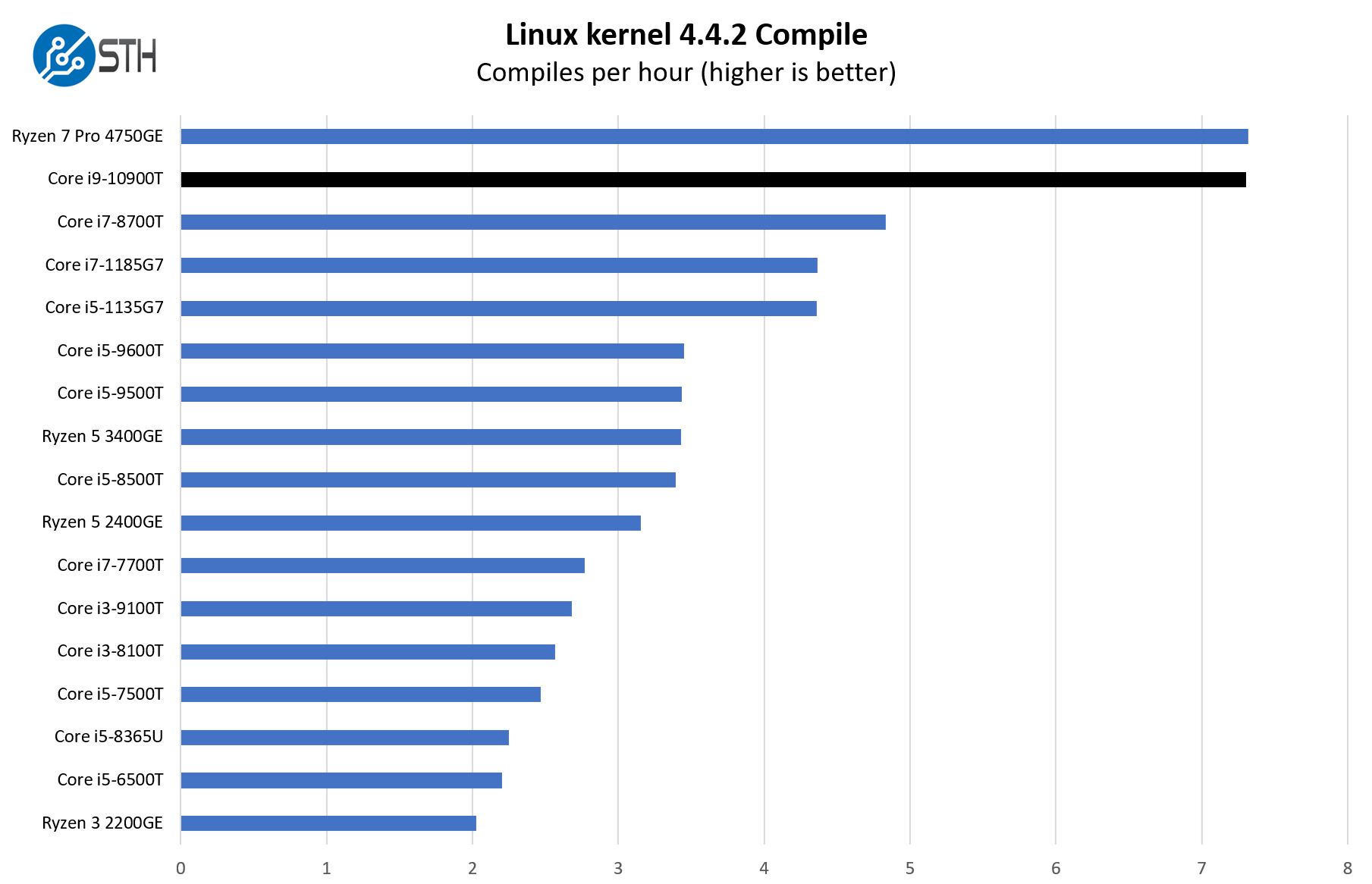
Overall the Intel Core i9-10900T performs very well. Our tests are designed to let full heat soak to set in due to the fact we test a lot of servers. There, we do see some impacts of running 10 cores/ 20 threads in only 35W TDP. We will discuss power later, but that is a major story with this CPU. Still, we ordered this SKU because it was the biggest available and Lenovo had good coupons which made it more reasonable. As a quick note here, we are testing with 2x 32GB DIMMs not the single 4GB DIMM because we wanted to test on a similar configuration to the rest of the high-performance units we have tested to date.
7-zip Compression Performance
7-zip is a widely used compression/ decompression program that works cross-platform. We started using the program during our early days with Windows testing. It is now part of Linux-Bench.

This is a great example of where the higher-core count CPU can really perform well. We see some nice performance gains over other generations and over the Ryzen 7 4750GE.
OpenSSL Performance
OpenSSL is widely used to secure communications between servers. This is an important protocol in many server stacks. We first look at our sign tests:
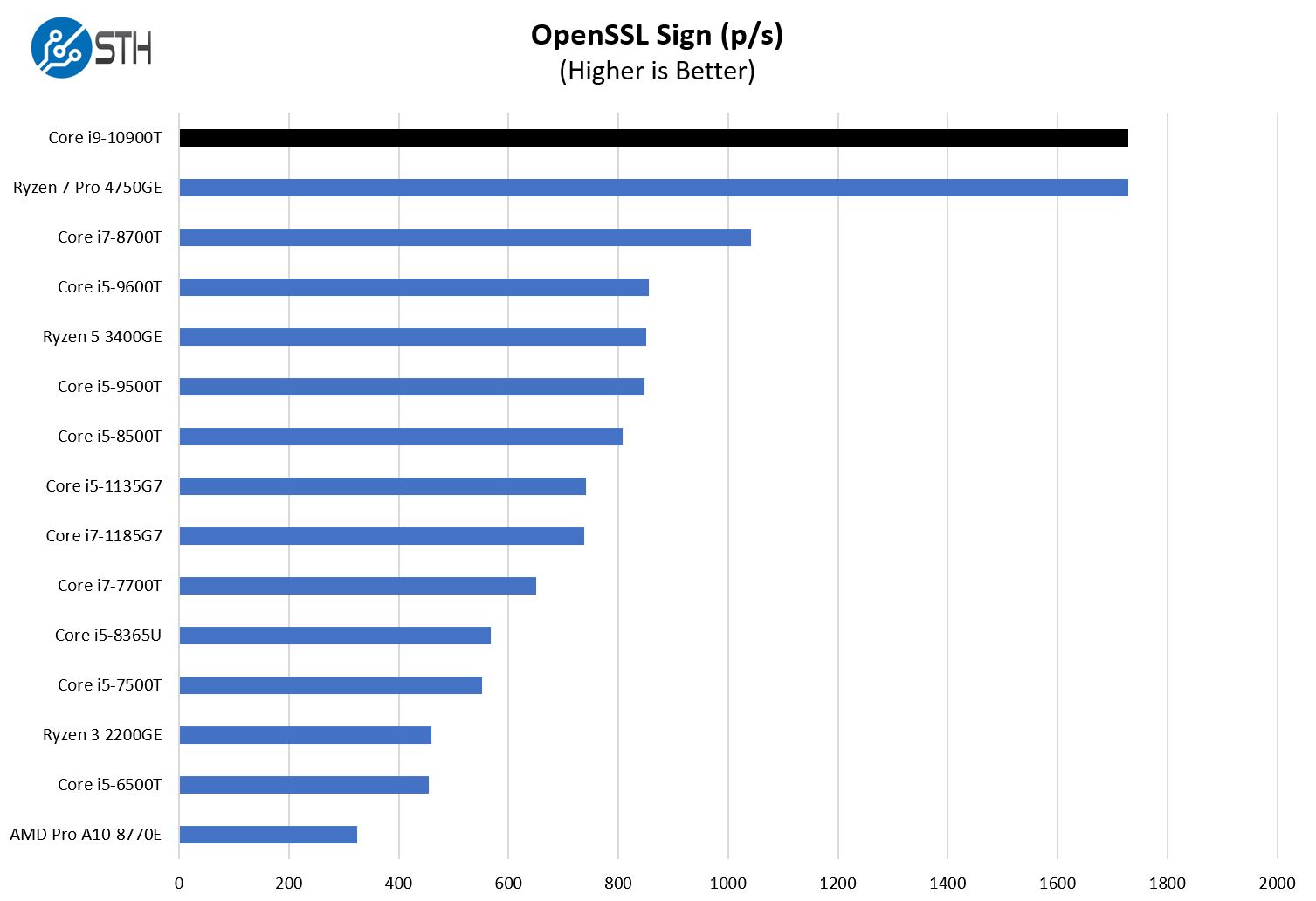
Here are the verify results:
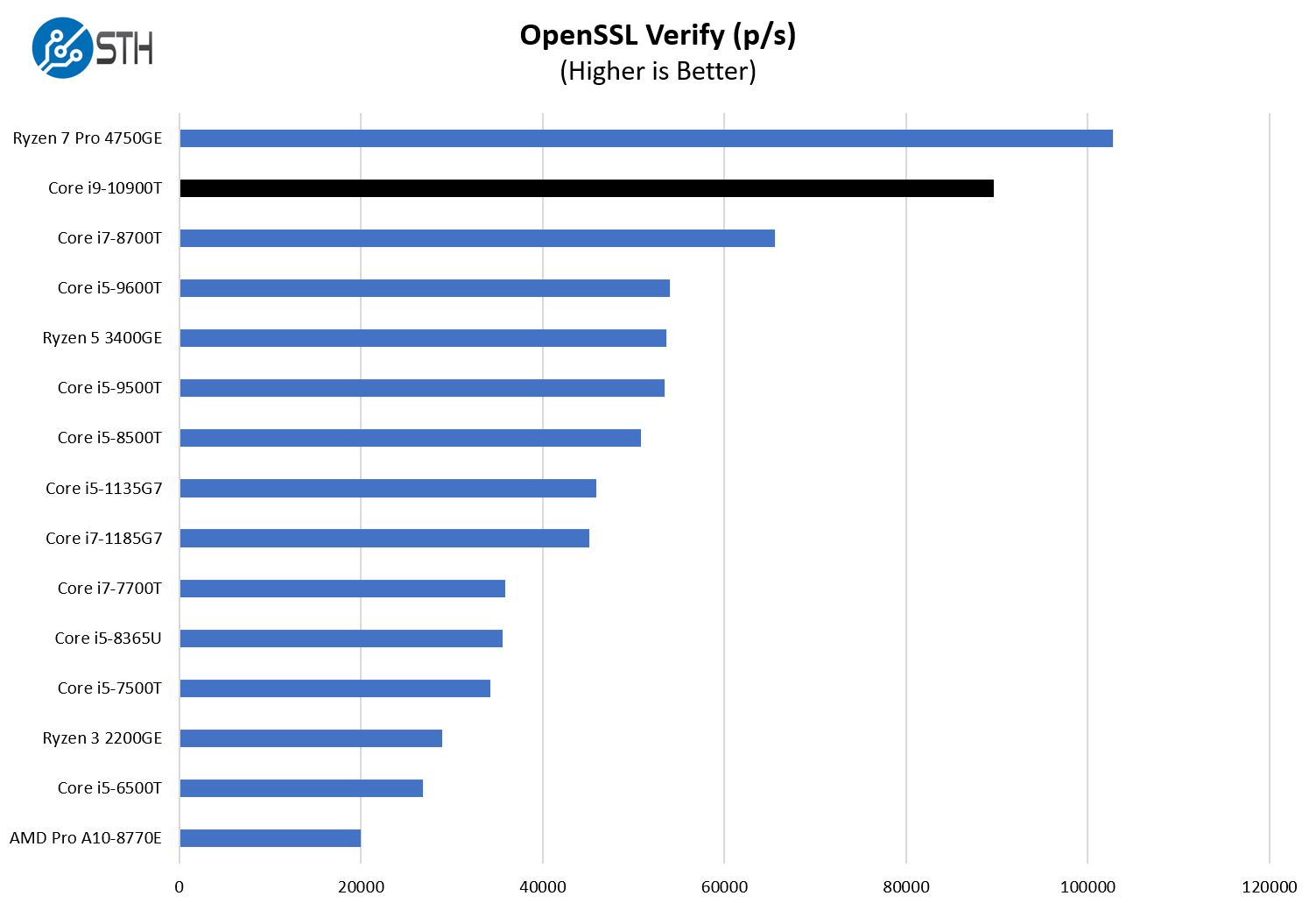
The two ways to look at the 35W TDP Intel Core i9-10900T system are that when the CPU is not overly constrained by that TDP limit, it performs better than the AMD parts. If it is constrained, it is closer to what AMD offers in 8-cores. At this end of the spectrum, the TDP is a major limiting factor.
Next, we are going to take a look at power consumption before getting to our key lessons learned and final words.


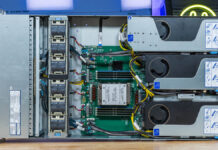
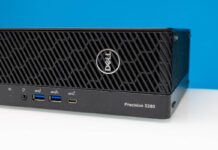
Great review – I’ve been loving these TMM reviews as I found the Prodesk 600/800 G3 units useful for home office or HTPC machines before prices went crazy due to COVID.
I think I can solve your Oumuamua mystery – it looks like the protective cover for the tiny RF connectors that push down onto the AX201 module. Anyway, love your site & have been reading for quite a few years now.
Where can I find the riser/Intel i350 option? It does not seem to show up in the configuration module, it seems.
The riser/Intel i350 option is not available in EMEA because “the product manager decided it wasn’t required.” This was also that person’s decision for the previous generation Tinys. It is available, as far as I know, in all other regions.
Note Patrick that it’s probably important to point out that this is the only model in this Tiny generation which supports a riser card and PCIe slot, the M70q and M80q do not.
I take it back. Literally over the weekend the listing on Lenovo UK has been updated and it now looks like a PCIe slot is available on the M90q Gen 2.
[premature submission] … whereas it was not before, and it looked like the M90q was going to be the last Tiny with a PCIe slot. I’m relieved!
Still worth making the point that the M90q and M90q Gen 2 (when you review it) are the only models with PCIe slots.
I bought a m90q for myself some weeks ago. It shall become my new audio workstation. For in- and outputs I want to connect an old M-Audio Project Mix interface with a firewire 400 port. When ordered the computer I thought it would be easy to install a firewire pci-e card. But no chance if you do not have the original Lenovo riser card, and this card is not available. I checked many sources here in europe and off course also Lenovo’s spare part partner IPC-computer in germany. Does anybody know where to get a pci riser card no. 5C50W00876. Any info is highly appreciated.
Hi Patrick, i already have an m90q with core i5 10500T, and i wish to upgrade to i5 11500, is this possible, i check the chipset and the chipset support the 11th gen, but i m not sure, i hope you can help me
Nick
The Mentioned 5C50W00876 part is avaiable both on Ebay and AliExpress.